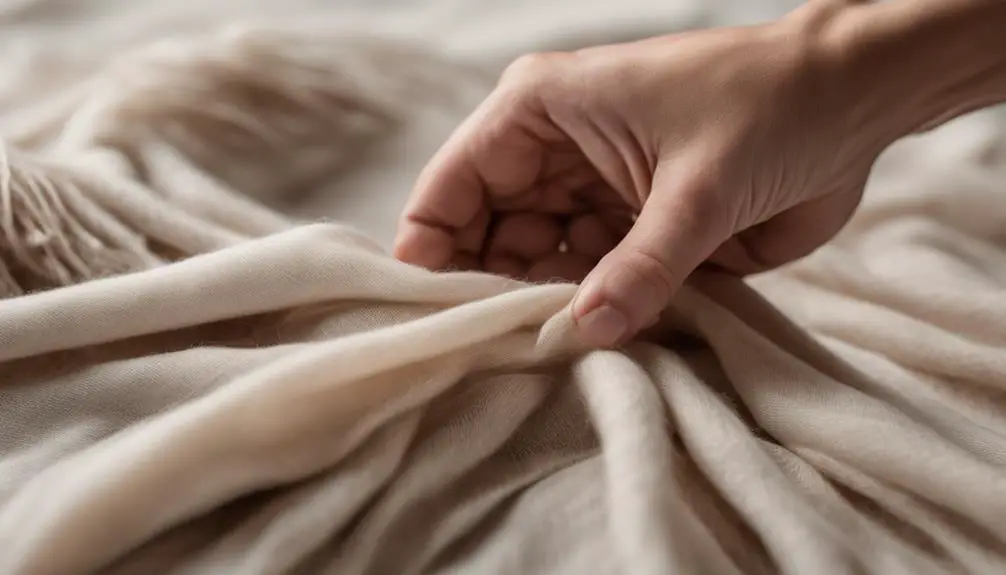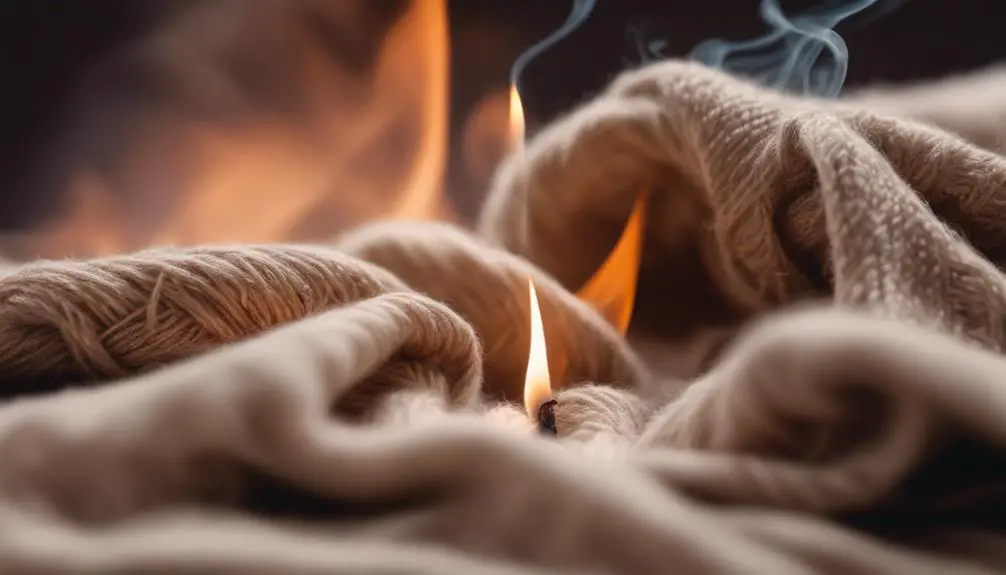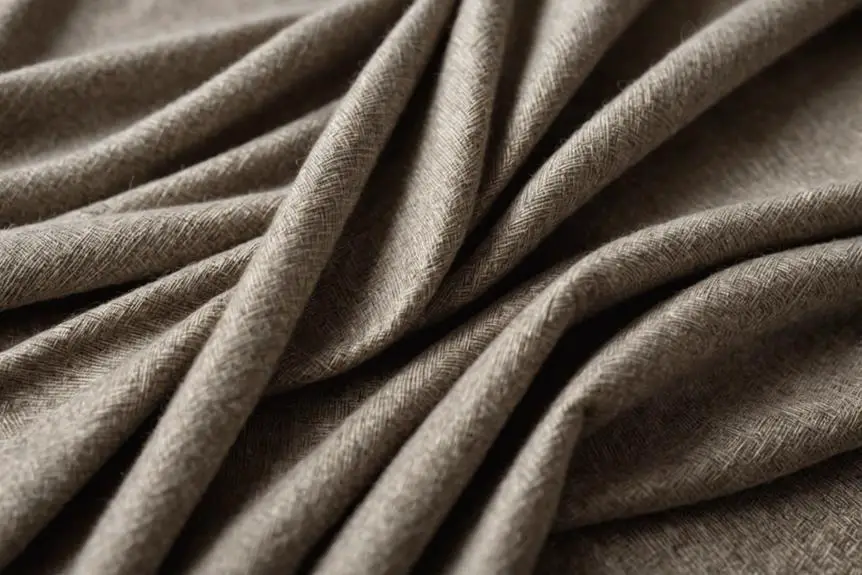When you're trying to identify authentic Pashmina wool fabric, it's crucial to pay attention to specific characteristics that distinguish it from lower-quality alternatives. Start by examining the fabric's texture and appearance; a soft matte finish with a subtle sheen is a good indicator of authenticity. You might also consider the fiber diameter and conduct a burn test, but these steps can be tricky if you're not familiar with them. Understanding these nuances can greatly enhance your ability to discern genuine Pashmina from imitations, and there's more to uncover about its unique qualities.
Understanding Pashmina Characteristics

When it comes to identifying Pashmina wool fabric, understanding its unique characteristics is essential. You'll quickly discover that Pashmina is a luxury textile sourced from the fine undercoat of Changthangi goats. This natural fibre is incredibly soft and warm, making it perfect for those cozy luxury Pashmina scarves you've been eyeing.
One of the first things to check is the diameter of the fibers. Authentic Pashmina fibers range from 14 to 15.5 microns. If it's above 19 microns, you might be looking at something synthetic or lower quality, which is a bummer! Next, consider the finish. Pure Pashmina has a unique matte look with just a hint of sheen from silk blending. If it's too shiny, it's likely a fake.
Another cool feature of genuine Pashmina is its irregular weave patterns, a result of handloom production. This craftsmanship is a sign of authenticity, so keep an eye out for those charming little quirks. And don't forget about pilling! While it might seem annoying, pilling is actually a sign of genuine fiber. Synthetic materials don't form pilling the same way, so if you see it, you're on the right track.
Visual Appearance of Authentic Pashmina
Authentic Pashmina stands out with its distinctive visual qualities that reflect its luxurious nature. Right off the bat, you'll notice its matte finish—this is a big deal! If it shines too much, it could be a sign of synthetic materials. You want that natural look, hinting at the real deal.
Now, let's talk about the fabric's weave. Genuine Pashmina features an irregular weave, a proof of its handloom production. When you hold it up to the light, those little imperfections are not flaws; they're marks of authenticity! It's like a badge of honor for your Pashmina.
Speaking of honor, the texture is where authentic Pashmina really shines. It's soft against the skin, almost like a gentle hug! If you feel something rough or itchy, you've likely stumbled upon an imitation. That luxurious texture is what you're after, trust me.
Don't forget to do a visual inspection for pilling. Real Pashmina may show natural pilling over time, while synthetic blends typically don't. Keep an eye out for that! And here's a quick tip: the fiber diameter of authentic Pashmina is usually between 14 to 15.5 microns. If you find something over 19 microns, you might be looking at a fake.
Conducting Physical Tests

To truly confirm the authenticity of Pashmina wool, conducting physical tests is essential. You'll want to start with the rubbing test. Rub the fabric between your hands; if it creates static electricity, it's likely synthetic fibers. Genuine Pashmina should be smooth and won't attract dust or hair. Next up is the burn test. Snip a thread from the fringe and carefully burn it. If it smells like burnt hair and leaves behind powdery ashes, you've got yourself some authentic Pashmina. If it smells like burnt plastic, well, that's a red flag!
Don't forget the glue test! Try sticking a label on the fabric. If it sticks, that's a sign of a counterfeit since genuine Pashmina tags are stitched on. You want to see that craftsmanship, not glue. Then, there's the shine observation. Hold the fabric up to the light; authentic Pashmina has a soft matte finish. If it shines too much, you could be dealing with a synthetic blend.
Lastly, keep an eye on pilling. Genuine Pashmina naturally pills after a few uses, while synthetic versions often stay smooth and sleek. So, why go through all these tests? Because you deserve to flaunt the real deal! With these simple checks, you'll be well on your way to spotting genuine Pashmina and avoiding those pesky fakes. Happy testing!
Analyzing Pilling and Wear
Pilling and wear provide significant insights into the authenticity of Pashmina wool. If you notice tiny fuzzy balls on the surface of your fabric, that's pilling, and it's perfectly normal for genuine Pashmina. This isn't a sign of a low-quality material but rather an indication of its authenticity. Real Pashmina is made from genuine animal fibers, and that natural pilling indicates you've got something special. On the flip side, if your fabric looks too pristine with no signs of pilling, you might be dealing with synthetic blends or imitation materials.
Now, let's talk about wear. Authentic Pashmina develops a unique character over time. You'll find that it softens and gains a luxurious feel, making it even more delightful to wear. Think of it like a fine wine that gets better with age! Fake versions, however, often stay looking new and untouched, which can be a big red flag.
Don't worry too much about pilling, though! You can manage it with specialized tools designed just for this purpose. A little care goes a long way in maintaining your Pashmina's appearance. So, if you're loving that soft feel and the character that comes with wear, celebrate it! Remember, the more you wear your Pashmina, the more it reveals its authenticity. Isn't that what makes owning a piece of real Pashmina so exciting? So, check for pilling and embrace the wear—it's all part of the journey!
Performing the Burn Test

When it comes to confirming the authenticity of your Pashmina wool, performing the burn test can really help you out. This simple test can reveal if you've got genuine Pashmina or a counterfeit Pashmina in your hands. To start, grab a small thread from the fringes of the fabric and carefully ignite it with a lighter or match—just make sure you're in a safe environment, away from any flammable materials!
Now, pay attention to the smell. When you burn genuine Pashmina, it'll give off a distinct burnt hair smell. If it smells more like burnt plastic or leaves, that's your first clue that you're dealing with synthetic fibers. But wait, there's more! After the thread burns, check the ashes. Authentic Pashmina will leave you with powdery ashes that crumble easily between your fingers. Synthetic materials? They'll often leave hard remnants or beads behind, which is a big red flag.
Frequently Asked Questions
How to Identify Pashmina Wool?
When you're diving into the world of Pashmina, it's all about sourcing that fine texture! Check out those unique weaves and patterns; they tell a story. Feel the softness—real Pashmina is durable and ages beautifully. You'll notice it's not shiny, just a lovely matte finish. And hey, if you're into vibrant dyes, that's a bonus! Pashmina care is simple, too. Just remember, it's an investment worth every penny! So, ready to rock that Pashmina?
What Are the Characteristics of Pashmina Wool?
Pashmina wool's got it all! You'll love its soft texture and luxurious feel that wraps you in lightweight warmth. The delicate sheen adds a touch of elegance, while the natural fibers offer amazing breathability properties. Plus, it's durable, so it lasts. With beautiful color variations, you'll find something for every outfit! Just remember to follow care instructions to keep it looking fabulous. Isn't it great to wear something ethically sourced?
What Is the Difference Between Pashmina and Pure Wool?
So, what's the real difference between Pashmina and pure wool? Well, Pashmina comes from the Changthangi goat, making it super soft and warm, while pure wool's just coarser sheep wool. Pashmina's fibers are finer, giving it a unique texture and a lovely sheen, especially when mixed with silk. Plus, it's handwoven, so every piece is special! It's pricier, but think of it as an investment in style and comfort. Who wouldn't want that?
What Is the Difference Between Pashmina and Faux Pashmina?
So, you're curious about pashmina versus faux pashmina? Pashmina originates from the fine wool of Changthangi goats, and it's super soft and warm, with cultural significance in fashion. Faux pashmina, on the other hand, is made from synthetic materials, so it's often rough and shiny. While pashmina can be pricey and sustainable, faux pashmina's more affordable and widely available. But remember, it won't give you that cozy, authentic feel like real pashmina!
Conclusion
So, there you have it! Spotting authentic Pashmina isn't rocket science, right? Just remember to check for that soft finish, do a burn test, and look out for those fine, powdery ashes. And don't be scared of a little pilling; it just means you've got quality! Next time you shop, you'll feel like a Pashmina pro. Who knew fabric could be so exciting? Happy hunting, and may your wardrobe be filled with the best of the best!




